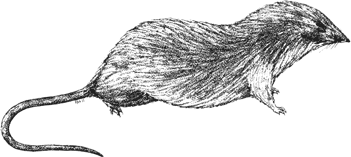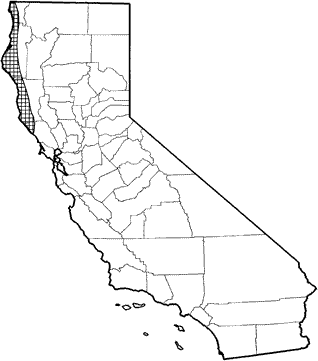
Marsh Shrew
Distribution, Abundance, and Seasonality
The marsh shrew is found along the Pacific Coast from British Columbia south to Sonoma Co. in California. Usually found in marshy areas (fresh emergent wetland habitat), but also found in valley foothill riparian habitat, and during winter rains may frequent moist forests as far as 1000 m (3300 ft) from running or standing water (Pattie 1973). Abundance of the marsh shrew is unknown in prime habitat; it is uncommon to rare in winter in moist forest habitats.

Range Map
Specific Habitat Requirements
Feeding: Preferred foods are eathhworms, sowbugs, spiders, centipedes, termites, and other soft-bodied arthropods captured above ground, and aquatic arthropods captured under water (Pattie 1969). Forages on the ground surface in humus and logs. Forages beneath water, swimming and probing with snout and whiskers, and carries prey to land for consumption or storage. Consumed nymphal stoneflies, mayflies, and alderflies, also phantom crane flies, ground beetles, snails, slugs, spiders, and other invertebrates (Whitaker and Maser 1976).
Cover: Often found under logs (Ingles 1965).
Reproduction: One nest was found under the loose bark of a Douglas-fir that had fallen over a stream, and was composed of shredded bark fibers (Maser et al. 1981).
Water: No data found on drinking, but found near water. Forages under water, and spends much time under water.
Pattern: Dense, mature riparian habitats with logs or litter are preferred for foraging and nesting. Adjoining dense, mature, wet forests for winter dispersal also may be important.
Species Life History
Activity Patterns: Appears to be primarily crepuscular and nocturnal, but occasionally is trapped during the day.
Seasonal Movements / Migration: During the wet winter, young (and others) may disperse to wet forest habitats (Maser et al. 1981), but are basically non migratory.
Home Range: No data found.
Territory: No data found.
Reproduction: Information is scarce. Sexually active males have been collected from February to August; sexually active females were trapped in May, June, and July (Pattie 1969). One litter was found in March. Litter size probably 3-4, with 4 most frequent.
Niche: Predators are likely to be owls, feral cats, Pacific giant salamanders, and large fish. Whitaker et al. (1980) found marsh shrews are externally parasitized by mites.
Comments: This species is poorly studied.
Sources & References
California Department of Fish and Game, 1999.
California's Wildlife, Sacramento, CA.
Written by: V. Johnson, R. Duke, reviewed by: H. Shellhammer, edited by: R. Duke
Ingles, L. G. 1965. Mammals of the Pacific states. Stanford Univ. Press, Stanford, CA. 506pp. Maser, C., B. R. Mate, J. F. Franklin, and C. T. Dyrness. 1981. Natural history of Oregon coast mammals. Pac. Northwest For. And Range Exp. Sta., USDA, For. Serv., Gen. Tech. Rep., PNW-133. 496pp. Pattie, D. L. 1969. Behavior of captive marsh shrews (Sorex bendirii). Murrelet. 50:27-32. Pattie, D. L. 1973. Sorex bendirii. Mammal. Species No. 27. 2pp. Whitaker, J. O., Jr., and C. Maser. 1976. Food habits of five western Oregon shrews. Northwest Sci. 50:102-107. Whitaker, J. O., Jr., G. L. Teiben, and C. Maser. 1980. Mites (excluding chiggers) from the fur of five species of western Oregon, USA, shrews. Northwest Sci. 54:26-29.
California Animal Facts | California's Wildlife